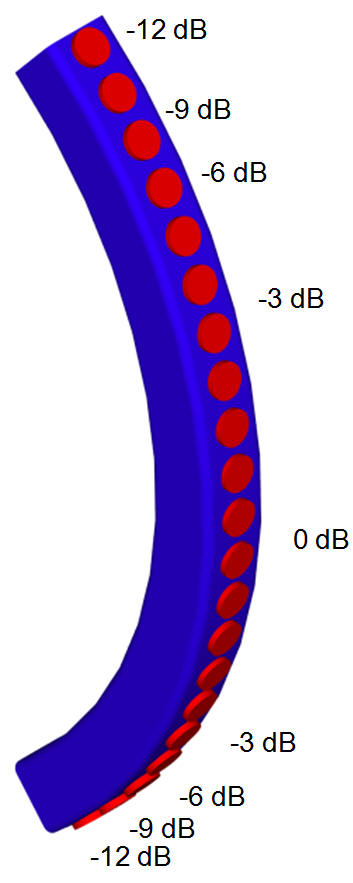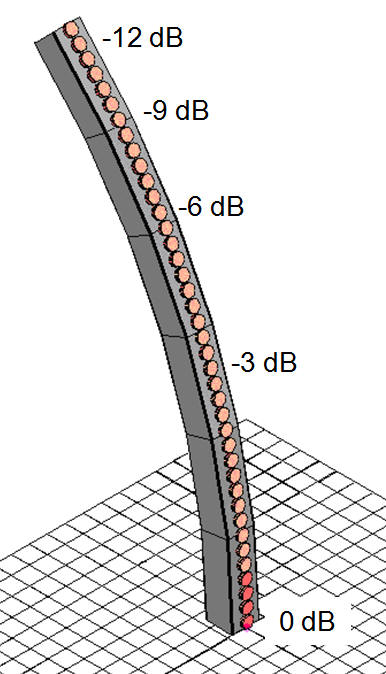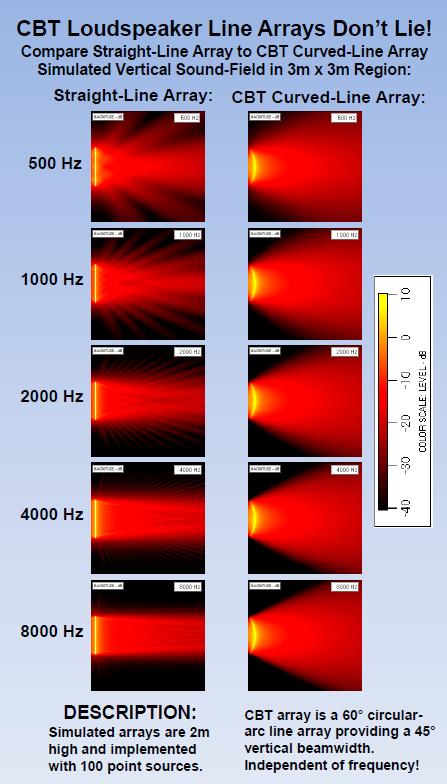@amirm
Thanks for taking the time to test the speaker, and for doing this service to the audio community that you seem to tirelessly attend to!!! I see you will do the bass module next - I suppose they are too tall to be tested together?
As to my experience/opinion on using 13 of these JBL CBT 70j-1 speakers in a 9.8.4 HT setup; I've posted that previously in post 3 linked below, so I'll let you read more there if inclined.
https://www.audiosciencereview.com/...eakers-in-commercial-project.310/#post-435727
In summary, I think they are fantastic. Someone asked about stereo listening. They are a very different sound than what you are most likely familiar with in traditional speakers. They have a sweet spot a mile wide, as in you could literally be in the chair on the either side of the center, main listening position, and it would sound like you are in the main listening position. This compared to many high end audiophile speakers I've auditioned in various home theaters that seem to have a very clear single centered sweet spot about 6" wide.
The CBTs do not have that focused center image sound that a stereo purist might seek, rather it's more of an “all around you" sound. Stereo listening is almost like engaging a multispeaker DSP function. Sometimes when I'm stereo listening I have to double/triple check to see if Dolby Surround or multi channel stereo engaged. With all thirteen speakers in multichannel stereo it's uncanny. I can walk anywhere in my home theater and it all sounds the same. Kneel, sit, or stand. All Uniform sound. No hot spots, no weak spots. With the eight 18” subwoofers, the bass is uniform too. It's a party trick I always show new visitors. Most I've demoed for have never heard anything like it. AND because of the distribution of the sound via the multiple drivers in each speaker you can walk right up to the speaker played at reference volume and not wince. That character makes them a great choice for a surround speaker that has to be too close to a particular seating position.
These JBL weren't my first exposure to CBT / Line Array technology speakers, I've had a few experiences and I've liked all of them.
My first audition was to the AVS123's LS6 and LS9.
I heard them at a few audio meets, and one of my friend's has a pair. They sounded great, but discontinued, HUGE, complicated, and now expensive, I wasn't going to buy a set of 13 of these.
-----------
The second exposure was to a set of Selah Game Changer Line Arrays at a "Heavy Hitters" blind testing audio meet in PA. The Game Changers stole the show for me. They were diminutive, the smallest speaker in the lineup, and I initially smirked that they entered a big boys competition because they had such tiny little drivers. In the blind audition, they filled the room completely - sounding the same everywhere, and blew me away. I had no idea what speaker was playing, but it was my favorite and I was incredibly surprised I picked them as my favorites over the other much more visually imposing candidates. Again too expensive for me, but I sure liked them!
Video footage of that Heavy Hitters G2G and meet. What fun!
(13) Gorilla83's Home Theater Heavy Hitters Meet, with stops at Popalock's, Craig John's, and DMark1's - YouTube
The blind testing day starts at around the 18:30 mark. (Some crazy stuff in this video -- want to see what 16, eighteen inch subwoofers do in a home theater? Skip to timestamp 15:35)
-----------
My third experience hearing a CBT design was at Axpona 2017 when Don Keele (the designer behind the CBT design) helped introduce the Epique CBT24K speaker as an audio speaker in partnership with Parts-Express. I walked by a mammoth pile of speakers (various products P.E. carried) with the CBT24K out front stand alone. As I walked by the display the sound was like a uniform wall, it sounded the same no matter where I walked within about a 20 foot range in the hotel lobby. It truly baffled me because I couldn't tell where the sound sourced from. It wasn't directional and barely changed volume as you walked closer or further away from the stack of speakers? How weird! The buddy I was with asked me if the sound was from the Epique line arrays, since he spotted and recognized Don Keele talking among the passer-bys, and understood the technology more than me. I told him no - it didn't sound like those little speakers could be doing that big sound, so I proceeded to walk up to the mountain of speakers and start putting my ear next the various drivers trying to figure out what speaker was producing such a uniform sound regardless of where you walked ---- were all the speakers on I initially wondered? I came to the realization it was, in fact, the little Epique CBT pair with tiny 2.5" drivers. I was blown away yet again. My buddy and I both bought a pair right there at the trade show floor! Sadly I never got around to putting mine together. My intent was to put them in my living room. Life happens - it's still unfinished. Someday?

-----------
My fourth experience (actually my third experience chronologically) was the local Kansas City AMC Prime movie theater
This premium theater was setup with a full host of these JBL CBT 70j-1 speakers with the bass module 70je-1 mated to (brand new at the time) Dolby Atmos processing. I was blown away again. It was my favorite commercial movie theater sound experience I'd ever had - and nothing else was even close. The sound experience was amazing, the music as the credits rolled was utterly fantastic! My buddies and I after the movie spent time commenting on just how excellent the sound was, we took pictures of the speakers, and tried to identify them. I looked them up, $1200 a piece for the mainspeaker CBT 70j-1 and then another $600 a piece for the bass modules CBT 70je-1. Ouch! As you can see in the picture the AMC had a LOT of money in those JBL CBT speakers!
Ugh. Too expensive, yet again, but since these were a mass production speaker I figured I might have a good chance of getting some used cheaper. I set up an eBay alert and got occasional alerts for the next ~ 3 years. Finally an auction popped up locally with 34 JBL CBT 70j-1 that a company had used for a couple 5K races - and had stringed them along the race path (because of the CBT characteristic of losing SPL at half the rate per distance of a traditional speaker). The seller was about 60 miles away so I could do local pickup, and he was selling them cheap. I bought 13 for about $420 each.
There's more to the story, 10 of the 13 had an 8 ohm sandbox resistor that had failed, making a 10dB dip at 2Khz,
so I had a LOT of unscrewing and crossover solder work to do, but ultimately I got them all fixed with the guidance of some smart, helpful guys on the DIY board at avsforum - measured with a calibrated omnimic as overlaying each other correctly, and finally was good to go!
All 13 overlay each other correctly when measured from the same position (FR measurements taken indoors inside my home theater room - all from the same position to validate each speaker was working similarly), metal speaker grills removed in all instances — I use them without the grills)
While all were disassembled, I installed the
RGB 5050 lighting strips behind the tweeter array to match the AMC Theater look and that's where I now sit.
(I bought three more new last year, to eventually bump my HT system to 16 channels, and Amirm was sent one of the new units, which I tested before hand to verify it overlaid with my current 13 speakers in frequency response perfectly -- it did), so if the unit amirm measured was defective, then my 13 are also defective. (at least based on frequency response taken by my omnimic)
I've been through a lot of speakers in 15 years. (6 entirely different sets in my home theater room. Klipsch, Wharfedale, Elemental Designs, JTR, Mackie, and now these JBL CBTs) These are the first speakers where I feel like I'm done. I've had them now for about 3 years, I have zero intent of replacing them. Similar to my search for subwoofers, with both I've found my own place of satisfaction, and I do not need, or even desire to chase something else.
For cinema, I don't know that I've heard better than these speakers. I've observed that all matching speakers is an incredible boon in the world of atmospheric audio/object based audio, where the Dolby Atmos or DTS-X objects can move between any speaker seamlessly in your cinema, and I'm particularly pleased with the JBL CBTs for that purpose!
Anyway - long read, but I know I like line array and CBT designs from several different experiences, and have further confirmed it with my time of ownership. Your mileage may vary! Thanks again amirm for measuring the speaker and supporting the community!
If any of you are ever in the Kansas City Area and desire an audition of my setup let me know. I enjoy giving HT demos, and talking audio with other enthusiasts.








